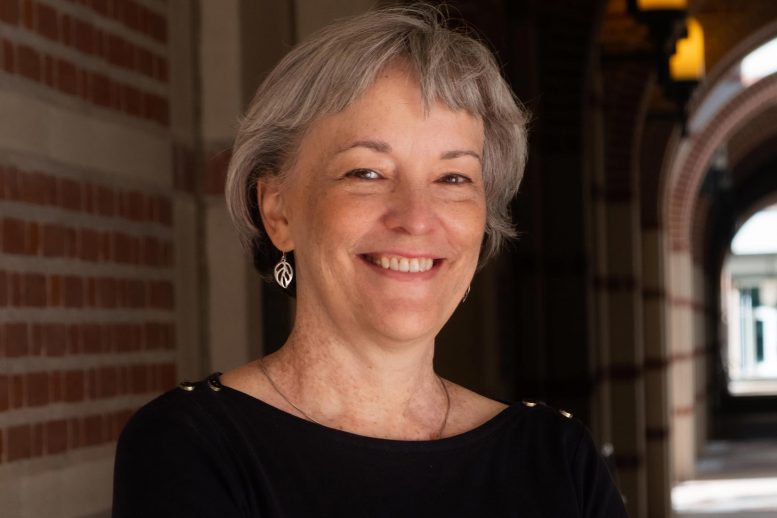Metabolic
Hidden structure found in essential metabolic machines – “I didn’t think it was real”
Membrane-separable compartments are visible in the peroxisomes of 4-day-old Arabidopsis thaliana plant cells in this image from a confocal microscope. The cells were genetically engineered to produce fluorescent proteins in both the membranes (green) and lumen (magenta) of the peroxisomes. Photo credit: Courtesy Zachary Wright / Rice University
Discovery “requires us to reconsider everything we thought we knew about peroxisomes.”
In his first year of graduate school, Rice University biochemist Zachary Wright discovered something hidden in a shared piece of cellular machinery that is essential to higher-order life from yeast to humans.
What Wright saw in 2015 – subcompartments within organelles called peroxisomes – is described in a study published today in Nature Communications.
“This is without a doubt the most unexpected thing our laboratory has ever discovered,” said study co-author Bonnie Bartel, Ph.D. Consultant and member of the National Academy of Sciences. “This requires that we rethink everything we thought we knew about peroxisomes.”
Peroxisomes are compartments in which cells convert fat molecules into energy and useful materials, like the myelin sheaths that protect nerve cells. In humans, peroxisome dysfunction has been linked to severe metabolic disorders, and peroxisomes may be of greater importance in neurodegeneration, obesity, cancer, and age-related disorders.
A lot is still unknown about peroxisomes, but their basic structure – a granular matrix surrounded by a sac-like membrane – was not questioned in 2015. Bartel said this was one reason Wright’s discovery came as a surprise.

Zachary Wright is a postdoctoral fellow in the Department of BioSciences at Rice University. Credit: Photo by Jeff Fitlow / Rice University
“We’re geneticists so we’re used to unexpected things. But they don’t usually come in Technicolor, ”she said, referring to another surprising thing at Wright’s Fund: beautiful color images showing both the walls of the peroxisome sub-compartments and their interiors. The images were possible due to brightly fluorescent reporters glowing protein tags that Wright used for the experiments. Biochemists modify the genes of model organisms – Bartels lab uses Arabidopsis plants – to label them in a controlled manner with fluorescent proteins that can provide clues about the function and dysfunction of certain genes, including some that cause disease in humans, animals, and plants .
Wright, now a postdoctoral fellow in Bartels lab, was testing a new reporter in 2015 when he discovered the peroxisome subcompartments.
“I never thought Zach was doing anything wrong, but I didn’t think it was real,” said Bartel. She thought the images must be the result of an artifact, a feature that wasn’t actually present in the cell but was created by the experiment.
“If this had really happened, someone would have noticed,” she recalled.

Bonnie Bartel is the Ralph and Dorothy Looney Professor of Life Sciences at Rice University. Credit: Photo by Jeff Fitlow / Rice University
“From that point on, I’ve tried to understand them,” Wright said. He checked his instruments, repeated his experiments and found no evidence of an artifact. He gathered more evidence for the mysterious subdivisions and ended up in the Fondren Library, where he combed through old studies.
“I revisited the really old literature on peroxisomes from the 1960s and found that they observed similar things and just didn’t understand them,” he said. “And that idea was just lost.”
There were a number of indications of these inner compartments in studies from the 1960s and early 1970s. In each case, investigators focused on something else and mentioned the observation in passing. All observations were made with transmission electron microscopes, which fell out of favor when confocal microscopy became widespread in the 1980s.
“It’s just a lot easier than electron microscopy,” said Bartel. “The whole field started with confocal microscopy. And in the early days of confocal microscopy, the proteins just weren’t that bright. “
Wright also used confocal microscopy in 2015, but with brighter reporters that made it easier to resolve small features. Another key: he examined peroxisomes from Arabidopsis seedlings.
“One reason this has been forgotten is that peroxisomes in yeast and mammalian cells are smaller than the resolution of light,” Wright said. “With fluorescence microscopy, you could only see one point at a time. That’s just the limit that light can reach. “
The peroxisomes he was looking at were up to 100 times larger. Scientists aren’t sure why peroxisomes in Arabidopsis seedlings grow so large, but they do know that germinating Arabidopsis seeds get all of their energy from stored fat until the seedling leaves can start producing energy from photosynthesis. Countless tiny droplets of oil support them as they germinate, and their peroxisomes have to work overtime to process the oil. When they do this, they become many times larger than normal.
“Bright fluorescent proteins combined with much larger peroxisomes in Arabidopsis made it extremely obvious and much easier to see,” Wright said.
But peroxisomes are also highly conserved, from plants to yeasts to humans, and Bartel said there is evidence that these structures may be common features of peroxisomes.
“Peroxisomes are a fundamental organelle that has been associated with eukaryotes for a very long time, and there have been observations across eukaryotes, often particularly mutants, where the peroxisomes are either larger or less proteinaceous and therefore easier to visualize.” said she said. Humans have not necessarily paid attention to these observations, however, as the enlarged peroxisomes are due to known mutations.
The researchers aren’t sure what the purpose of the subdivisions is, but Wright has a hypothesis.
“When you talk about things like beta oxidation or the metabolism of fats, you get to the point that the molecules don’t want to be in the water anymore,” Wright said. “When you think of a traditional type of biochemical reaction, we just have one substrate floating around in a cell’s aquatic environment – the lumen – interacting with enzymes. This doesn’t work so well when you have something that doesn’t want to hang around in the water. “
“Using these membranes to solubilize the water-insoluble metabolites and allow better access to lumenal enzymes could be a general strategy to deal with this type of metabolism more efficiently,” he said.
Bartel said the discovery also provides a new context for understanding peroxisomal disorders.
“This work could give us a way to understand some of the symptoms and possibly examine the biochemistry that is causing them,” she said.
Reference: “Peroxisomes form intralumenal vesicles with a role in fat acid Catabolism and Protein Compartmentalization in Arabidopsis ”by Zachary J. Wright and Bonnie Bartel, December 4, 2020, Nature Communications.
DOI: 10.1038 / s41467-020-20099-y
Bartel is the Ralph and Dorothy Looney Professor of Life Sciences at Rice. The research was supported by the National Institutes of Health (R01GM079177, R35GM130338, S10RR026399) and the Welch Foundation (C-1309).




